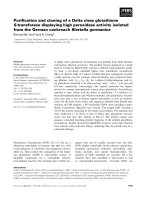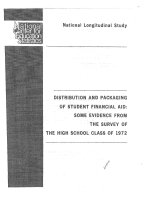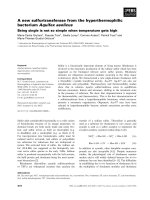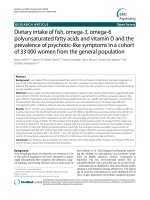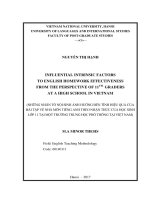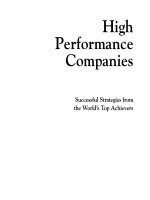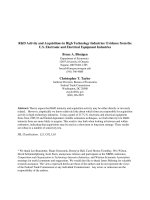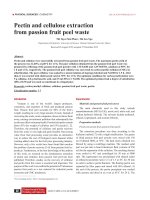High methoxyl pectin from the soluble dietary fiber of passion fruit peel forms weak gel without the requirement of sugar addition
Bạn đang xem bản rút gọn của tài liệu. Xem và tải ngay bản đầy đủ của tài liệu tại đây (1.23 MB, 6 trang )
Carbohydrate Polymers 246 (2020) 116616
Contents lists available at ScienceDirect
Carbohydrate Polymers
journal homepage: www.elsevier.com/locate/carbpol
High methoxyl pectin from the soluble dietary fiber of passion fruit peel
forms weak gel without the requirement of sugar addition
T
Kahlile Youssef Abbouda, Marcello Iacominia, Fernanda Fogagnoli Simasb,*,
Lucimara M.C. Cordeiroa,*
a
b
Department of Biochemistry and Molecular Biology, Federal University of Paraná, CP 19.046, CEP 81.531-980 Curitiba, PR, Brazil
Department of Cell Biology, Federal University of Paraná, CEP 81.531-980 Curitiba, PR, Brazil
A R T I C LE I N FO
A B S T R A C T
Keywords:
Passion fruit peel
Soluble dietary fibre
High methoxyl pectin
Rheological analysis
Passion fruit peel (PFP) is a by-product from the fruit processing industry, accounting for approximately 50 % of
the fruit weight. It is well known for its health properties, although few studies evaluated its rheological
properties. PFP polysaccharides (PFPP) contain a high methoxyl pectin (HMP), specifically a 70 % methylesterified homogalacturonan. Flow behaviour analysis of PFPP (with or without sucrose) revealed a shearthinning non-Newtonian behaviour. Dynamic oscillatory tests showed a weak gel-like behaviour, even without
sucrose addition. Moreover, under simulated pasteurization process PFPP maintained its gel structure. Taken
together we demonstrated that PFPP has divergent behaviour from commercial HMP, since it does not require
sucrose or low pH to form gel. The present work reinforces the use of PFP as a source of soluble dietary fibres and
pectins, providing its alternative application as a rheological modifier in a wide range of products, including
those with low sugar.
1. Introduction
Passion fruit peel (PFP) is a by-product from the fruit processing
industry and it accounts for approximately 50 % of the fruit weight.
Brazil is the largest passion fruit producer worldwide, responsible for
more than 80 % of the production, reaching approximately five hundred thousand tons of fruit in 2017 (Albuquerque et al., 2019; de Souza,
Jonathan, Saad, Schols, & Venema, 2018; Souza & Gerum, 2017). The
underutilization of these peels may represent an important environmental issue. However, it could also represent a good source of bioactive components such as antioxidants, dietary fibres and vitamins. The
recovery of by-products holds great potential to be used as food additives by the food industry, as well as functional food ingredients or
nutraceuticals to be used for the prevention or treatment of human
conditions (Albuquerque et al., 2019; Kowalska, Czajkowska,
Cichowska, & Lenart, 2017). Therefore, these (by) products represent a
potentially convenient resource to be explored and their transformation
on high-added value compounds may be conducted towards the reduction of their impact in the environment. For most consumers, the
acceptability of industrialized products for daily use is improved when
natural ingredients are added instead of synthetic ones (Kowalska et al.,
2017).
⁎
Accordingly, PFP has been widely studied regarding its healthpromoting properties, including its metabolic effects (reduction of the
fasting blood glucose, triglycerides and glycated hemoglobin levels,
reduction of homeostasis model assessment for insulin resistance index
-HOMA IR and of the hepatic cholesterol levels), and action on the
gastrointestinal tract (gastroprotection, reduction of faecal pH and increase in the faecal moisture) (Abboud et al., 2019; Corrêa et al., 2014;
de Queiroz et al., 2012; de Souza et al., 2018; Macagnan et al., 2015;
Ramos et al., 2007). Furthermore, it contains dietary fibre (DF), mainly
pectin, which is considered a soluble dietary fibre (SDF). SDF are undigestible food compounds which comprises polysaccharides, such as
pectins, β-glucans, gums and some hemicelluloses (Englyst, Liu, &
Englyst, 2007).
Pectin is considered a traditional food ingredient and additive due
to its emulsifying, gelling, thickening as well as stabilising properties,
thus it has been widely studied for its physical-chemical and rheological
properties (Lopes da Silva & Rao, 2007). Despite its availability in a
large number of plant species, commercial sources of pectin are limited
to citrus and apple pomace, both by-products of the juice industry
(Chan, Choo, Young, & Loh, 2017; Kowalska et al., 2017). The search
for feasible alternative sources of pectin is increasing, as also the pectin
market, which is expected to grow and may reach 1370 million US$ by
Corresponding authors.
E-mail addresses: (F.F. Simas), (L.M.C. Cordeiro).
/>Received 21 March 2020; Received in revised form 5 June 2020; Accepted 5 June 2020
Available online 12 June 2020
0144-8617/ © 2020 Elsevier Ltd. All rights reserved.
Carbohydrate Polymers 246 (2020) 116616
K.Y. Abboud, et al.
study.
the end of 2025 (www.marketwatch.com). An important factor to
choose novel sources of pectin is the yielding. In this sense finding new
sources of pectin from different by-products, with distinct chemical
properties, would broaden their application as food additives, nutraceuticals or even biofuels. This may contributes to solve the problem
of waste management, which has been estimated in millions of tons
every year, and its consequent adverse impact in the environment
(Kowalska et al., 2017).
Homogalacturonan (HG) is the main component of pectins. It
comprises the “smooth region” of pectic domains, and is a linear
homopolymer of α-1,4-linked-D-galacturonic acid (GalpA) units that can
be methyl esterified at O-6 in different degrees. This is indicated by the
degree of methyl esterification (DE), which is expressed as the percentage of the total number of galacturonic acid residues esterified with
a methoxyl group. Depending on DE, pectins can be classified as the
High-Methoxyl (HMP, where DE > 50 %) and Low-Methoxyl (LMP,
where DE < 50 %) (Chan et al., 2017; Einhorn-Stoll, 2018; Yapo,
2011).
HMP are well known regarding their gelling properties, for so they
are widely exploited by different types of industries as a rheology
modifier and stabilizer, as well as in sugary products (Lopes da Silva &
Rao, 2007). HMP behave differently from LMP. In order to form gel,
HMP requires low pH (< 3.5) conditions and high sugar concentrations
(> 55 %), while LMP require divalent ions, such as calcium, and wider
range of pH (2–6), but have no need for sugar addition (BeMiller, 2019;
Chan et al., 2017). The acidic pH promotes the decrease of electrostatic
repulsive forces among high methoxyl pectic chains by the protonation
of the carboxyl groups. To decrease the water activity and boost chainchain interactions, large amount of sugar (i.e. sucrose) are used with
HMP. Lastly, HMP gel formation is governed by two main non-covalent
types of interactions: hydrophobic interactions between methoxyl
groups; and, hydrogen bonds set between secondary alcohol groups and
non-dissociated carboxyl (Oakenfull & Scott, 1984). For those reasons,
as well as to their ability to form spreadable gels, HMP is mainly applied to jellies, jams, preserves and marmalades (BeMiller, 2019).
There is limited information regarding the rheological properties of
passion fruit pectins. Yapo and Koffi (2006) evaluated the gelling
ability and viscoelastic properties of a low methoxyl pectin extracted
from passion fruit peel from Ivory Coast, while Canteri et al. (2010)
determined the reduced viscosity of an HMP obtained from different
portions of PFP (exocarp, mesocarp and endocarp) extracted with
0.05 mol/L nitric acid at 80 °C.
We have chemically characterized a high methoxyl pectin (DE 70
%), extracted from passion fruit peel (Abboud et al., 2019), with Mw
53 kDa and composed mainly of galacturonic acid (92 %). It presented
higher DE and lower neutral monosaccharides amounts compared to
other sources of HMP (Barbieri et al., 2019; Colodel, Vriesmann, &
Petkowicz, 2019; Nascimento, Simas-Tosin, Iacomini, Gorin, &
Cordeiro, 2016). Since these structural characteristics are important for
the rheological properties of high methoxyl pectins (May, 1990;
Thakur, Singh, & Handa, 1997), the main objective of this work was to
evaluate the rheological properties of the high methoxyl pectin extracted from PFP aiming its application as a rheological modifier by the
industry in a wide range of products, including those with low sugar.
2.2. Sample preparation and rheological analysis
PFPP dispersions were prepared in ultrapure water at 2% and 4%
(w/w) concentration being stirred overnight at room temperature.
Samples with sucrose were prepared according to Vriesmann, Silveira
and Petkowicz (2010). PFPP at 2% (w/w) and sucrose at 25 % or 50 %
(w/w) were mixed and stirred overnight. Then, the mixture was heated
at 92 °C for 15 min in a water bath, under stirring, after that it was
cooled and its pH adjusted to 3.0 with a saturated solution of citric acid.
Lastly, these samples were hermetically sealed and stored at 4 °C for 1
or 2 days until analysis.
A HAAKE MARS II rheometer was used to conduct analysis, at 20 °C
with a cone-plate (C60/2◦TiL) measurement system with maximum gap
of 1 mm. The temperature was controlled by a circulating water bath
(DC5, Haake) coupled to a Peltier temperature control device (TC81,
Haake). In order to allow the equilibrium of the temperature in the
sample dispersions, they were placed on the rheometer plate for 300 s
before all rheological analysis.
Flow curves were assessed in the controlled shear rate (CR) mode
through the application of increased shear rate (0.001 - 1000 s−1) for
300 s. The shear stress (τ) and the apparent viscosity (η) were evaluated
as a function of shear rate and, the data of flow curves analysed and
fitted according to the rheological models of Herschel–Bulkley
(τ = τ0 + Kγ˙ n) and Ostwald–de Waele (τ = Kγ˙ n) , where τ is the shear
stress (Pa), K is the consistency index (Pa sn), γ˙ is the shear rate (s−1), n
is the flow behaviour index (dimensionless) and τ0 is the yield stress
(Pa) (Rao, 2007).
The frequency sweeps were carried out with controlled deformation
mode using 1% strain in the 0.02–10 Hz range. G’, which is the elastic
modulus associated to the solid response of the material and, G” which
is the viscous modulus, corresponding to the fluid response of the material (Zhong & Daubert, 2013), were analysed.
In order to study the behaviour of PFPP dispersions after they were
submitted to pasteurization processes, which is a relevant procedure to
food products, the rheometer plate was previously heated to 88 °C and
PFPP dispersions were poured on the warm plate, resting for one
minute. The sensor was covered with a sample hood (POM 222–1903)
to prevent water evaporation. Subsequently, the temperature decreased
to 4 °C at a rate of 2 °C per minute, at a fixed frequency of 1 Hz and
strain of 1%.
The rheological and statistical parameter were obtained by the
software RheoWin 4 Data Manager. All the analyses were performed, at
least, in three independent experiments. Graphics show the mean values and corresponding standard error of the mean (SEM).
2.3. Scanning electron microscopy (SEM)
PFPP was analyzed by scanning electron microscopy (SEM) (Model
VEGA3 LMU, Tescan, Kohoutovice, Czech Republic), equipped with a
detector (SDD 80mm2) and AZ Tech Advanced software. The electron
micrographs were obtained at a 15-kV accelerating voltage. The lyophilized PFPP was posed on aluminum stubs with double-face tape.
Then, it was submitted to metallic coating with gold for 2 min with
thickness of 10 nm, under argon atmosphere, using metallic coating
equipment (Model SCD 030, Pfeiffer, Balzers, Liechtenstein). This procedure was carried out at the Electron Microscopy Center at the Federal
University of Paraná, Curitiba, Brazil.
2. Material and methods
2.1. Extraction of the passion fruit peel pectin (PFPP)
The high methoxyl pectin (PFPP) analysed here was previously
extracted and chemically characterized as homogalacturonan by
Abboud et al. (2019). Briefly, passion fruit peel flour was submitted to
the standard enzymatic-gravimetric method (Lamothe, Srichuwong,
Reuhs, & Hamaker, 2015) and fraction containing soluble dietary fibres,
which corresponded to 20 % of passion fruit peel fibres, was composed
of an HMP and corresponds to PFPP fraction employed in the present
3. Results and discussion
3.1. Steady-state shear properties of PFPP dispersions with or without
sucrose
Flow behaviour analyses of PFPP dispersions at different
2
Carbohydrate Polymers 246 (2020) 116616
K.Y. Abboud, et al.
Table 1
Rheological parameter based on PFPP flow curves.
Rheological Model
Ostwald de Waele
Herschel-Bulkley
PFPP
K (Pa.s)
n
r2
τ0
K (Pa.s)
n
r2
2% PFPP
2%
4%
25 % Sucrose
50 % Sucrose
0.2132
0.6062
0.9939
0.3971
0.1220
0.6879
0.9984
2.148
0.4792
0.9936
1.859
1.308
0.5524
0.9971
1.971
0.4946
0.9921
2.243
1.072
0.5839
0.9974
4.303
0.5208
0.9943
4.406
2.669
0.5912
0.9976
betaceum. Thus, it can be hypothesize that in the PFPP the junctions
zones arising from hydrophobic non-covalent interactions can be
formed in large amounts without sucrose and when this co-solute is
added only minor of these interactions were newly established. Furthermore, in that system the hydrogen bonds seems to be less decisive
in gel network, since sucrose could also facilitate this type of interaction
(May, 2000; Thakur et al., 1997; Strӧm et al., 2014).
Flow curves experimental data were fitted to rheological models,
such as Ostwald de Waele and Herschel-Bulkley with high regression
coefficients (R2) values (≥ 0.99) (Table 1).
These models are important since they may contribute to characterize flow behaviour of fluids on shear. Chemical and physical
properties of fluids may influence flow behaviour affecting industrial
systems productivity and improvement, as well as the orientation of
equipment operation regarding heat transfer phenomenon, velocity and
volumetric flow rates in channel and tube flows (Doran, 2013; Rao,
2007). The Ostwald-de Waele model, also referred as power law model,
stipulate parameters of flow behaviour (n) and consistency (K) index, in
which shear-thinning fluids present n < 1 (Rao, 2007). As shown in
Table 1, all samples demonstrated flow behaviour (n values) lower than
1, indicating shear-thinning behavior. Similarly, Herschel-Bulkley
models also provide information on flow behaviour and consistency
index, although with an extra parameter, the yield stress (τ0), in which
non-Newtonian fluids demand finite stress (τ0), a necessary stress to
fluid to start to flow. Accordingly, these materials behave as rigid solids
until the yield stress is exceeded and the material flows as shear-thinning fluid, therefore samples presenting positive τ0 values, will flow as
power-law fluid (Alexandrou, McGilvreay, & Burgos, 2001). As represented in Table 1, τ0 values were increased as the sample concentration increased, and the same occurred for the samples prepared
with sucrose.
Fig. 1. Influence of shear rate (0.001 - 1000 s−1) on the apparent viscosity of
PFPP from passion fruit peel at 25 °C at different concentrations on water, with
or without sucrose.
concentrations, with or without sucrose addition, were performed to
evaluate apparent viscosity in response to increasing shear rates
(Fig. 1). The results for both, PFPP aqueous dispersions at 2 and 4% (w/
w) showed that the increasing concentrations of PFPP improved the
apparent viscosity of the solution. Also, PFPP presented a characteristic
shear-thinning non-Newtonian behaviour, in which the viscosity decreases with increased shear rates. This is considered a typical behaviour for polysaccharide systems, where the three-dimension network
of the molecules exhibit a tendency to align on the flow direction,
dissociate or assume another conformation thus, reducing viscosity
(Lapasin & Pricl, 1995; Schramm, 2006). Likewise, this outline was seen
in water solutions, at different concentrations, of HMP extracted from
alternative sources (other than citrus and apple pomace pectin) (Chan
et al., 2017; Schramm, 2006).
PFPP at 2% and 4% (w/w) exhibited apparent viscosity values of
20.9 and 118 Pa.s at 0.01 s−1, respectively. These values were much
higher than those found for other HMP extracted from non-commercial
sources. Nascimento et al. (2016) found an apparent viscosity of approximately 0.2, 1.5 and 7 Pa.s at 0.01 s−1 for an HMP from the pulp of
Solanum betaceum at 3%, 5% and 8% (w/w) respectively. Likewise,
HMPs from Campomanesia xanthocarpa Berg fruit (Barbieri et al., 2019),
ponkan peel pectin (Citrus reticulata Blanco cv. Ponkan) and from
commercial citrus pectin (Colodel et al., 2019), at concentration of 5%
(w/w) presented apparent viscosity values close to 10 Pa.s under shear
rate of 0.01 s−1. Pectin from cocoa pod husks had apparent viscosity
values even low, approximately 1 Pa.s at the same shear rate
(Vriesmann & Petkowicz, 2013). In this sense, it is important to highlight that PFPP aqueous dispersions were 2–15 times more viscous than
other HMPs.
The viscosity of aqueous HMP generally are improved by addition of
high amounts of co-solutes, such as sucrose. Thus, we evaluated flow
behaviour of PFPP at 2% added with sucrose (25 % and 50 % w/w)
(Fig. 1). As expected, the apparent viscosity of PFPP at 2% was improved by the addition of sucrose, although it was not observed the
same enhancement when the sucrose amount was doubled. It is known
that sucrose decrease the water activity in aqueous dispersions of HMP
and further favour the junction zones establishment, increasing hydrophobic association between methoxyl groups from galacturonic
acids units (Thakur et al., 1997). However, in general, the viscosity
improvement with high amounts of sucrose (as 50 % w/w) can reach to
100,000 fold more than that observed without sucrose. HMP from Solanum betaceum (at 3%; w/w) showed an enhancement in the apparent
viscosity at 0.01 s−1, from 0.2 Pa.s to near 20,000 Pa.s after addition of
50 % (w/w) sucrose (Nascimento et al., 2016). PFPP at 2% with 50 %
sucrose showed only a 9-fold increase in the apparent viscosity, from
21 Pa.s, at 0.01 s−1, to near 188 Pa.s (Fig. 1). PFPP had lower Mw, low
amounts of neutral side chains and higher DE than HMP from S.
3.2. Dynamic rheological properties of PFPP with or without sucrose
One of the most important properties of pectins, as a raw material
for the industry, is their capacity to form gel. HMP dispersed in water
usually demonstrated a liquid-like behaviour, where G” is higher than
G’ in the whole frequency range analysed (Barbieri et al., 2019;
Nascimento et al., 2016; Vriesmann & Petkowicz, 2013; Vriesmann,
Silveira, & Petkowicz, 2010). Interestingly, as seen in Fig. 2A, PFPP
aqueous dispersion at 2 and 4% concentration (w/w), demonstrated
weak gel-like behaviour, where the elastic modulus (G’) presented
higher values than the viscous modulus (G”) in the whole frequency
range analysed, although these moduli are somewhat frequency dependent. As observed for other polysaccharides, the gel strength was
concentration dependent, and PFPP gel at 2% presented lower strength
than PFPP at 4% (Table 2). The dramatically increases on G’ and G”
values in frequency sweep (up to 4 Hz) of PFPP at 2% (Fig. 2A) could
suggest that low concentrated weak gel system was less resistant and
maybe at higher frequencies there is untangled in the gel network
structure.
A weak gel behaviour was also observed for 2% PFPP added with 25
3
Carbohydrate Polymers 246 (2020) 116616
K.Y. Abboud, et al.
Fig. 2. Frequency sweeps at 25 °C of PFPP aqueous dispersions with or without
sucrose. Elastic modulus (G’) is represented with full symbols while viscous
modulus (G”) with open symbols. (A) Frequency sweeps from PFPP at 2% and
4% (w/w). (B) Frequency sweeps from PFPP at 2% with 25 or 50 % sucrose (w/
w). (C) Comparison between the elastic modulus of all samples.
Fig. 3. Viscoelastic evaluation of PFPP weak gels under cooling after pasteurization simulated method, with or without sucrose. Elastic modulus (G’) and
viscous modulus (G”) as a function of temperature. (A) PFPP at 2% and 4% (w/
w). (B) PFPP at 2% with 25 or 50 % sucrose (w/w). (C) Comparison of elastic
modulus (G’) of all samples.
% or 50 % of sucrose (Fig. 2B, Table 2). Sucrose is a co-solute used to
promote gelation of HMPs, which generally are viscoelastic liquids in
the absence of a co-solute (May, 2000; Thakur et al., 1997). This expected behaviour was not observed here (Fig. 2B), since although sucrose increased the gel strength, it was not essential to gel network
establishment. As described in the above section, it seems that sucrose
is not essential to establish in PFPP the junction zones arising from
hydrophobic non-covalent interactions necessary to gel network formation. Thus, PFPP showed a distinct feature, it forms weak gels in
water (G’ > G” in all the analysed frequency range) without requirement of co-solutes or acidification. Barbieri et al. (2019) also observed a
gel-like behaviour for a pectin at 5% (w/v) aqueous dispersion from
Campomanesia xanthocarpa Berg., however, the gel was weaker (G’
values around 1 Pa, from 0.03 to 1 Hz) than PFPP at 4% (w/w), which
showed G’ values around 55 Pa in this frequency range.
Table 2
Elastic modulus obtained in dynamic oscillatory tests and ratio G’/G” of all samples, at different concentrations and frequencies.
Samples
PFPP 2%
PFPP 4%
PFPP 2% 25 % Suc.
PFPP 2% 50 % Suc.
Frequency (Hz)
G’ (Pa)
G’/G”
G’ (Pa)
G’/G”
G’ (Pa)
G’/G”
G’ (Pa)
G’/G”
0.02
0.1
1
10
3.70 ± 0.21
7.4 ± 0.88
42.48 ± 1.66
6.65 ± 0.63
17.05 ± 0.75
4.06 ± 0.58
36.88 ± 14.44
3.37 ± 2.28
4.75 ± 0.36
11.05 ± 1.77
53.54 ± 2.04
8.26 ± 0.91
25.55 ± 0.69
5.42 ± 0.52
63.84 ± 11.95
4.02 ± 1.18
5.44 ± 0.42
5.08 ± 0.8
64.94 ± 2.05
5.48 ± 0.67
34.72 ± 2.47
3.97 ± 0.54
96.87 ± 13.87
3.13 ± 0.77
nd
nd
80.10 ± 2.33
2.72 ± 0.3
49.35 ± 3.14
2.00 ± 0.22
148.48 ± 20.38
1.73 ± 0.41
4
Carbohydrate Polymers 246 (2020) 116616
K.Y. Abboud, et al.
Fig. 4. Scanning Electron Microscopy of PFPP. (A) 100×, (B) 1000× and (C) 5000× magnifications.
(Barbieri et al., 2019; Colodel et al., 2019; Nascimento et al., 2016;
Sousa, Nielsen, Armagan, Larsen, & Sørensen, 2015; Yoo, Fishman,
Hotchkiss, & Lee, 2006). Min et al. (2011) observed that the extraction
methods may influence the rheological behaviour of pectins obtained
from apple pomace. PFPP was isolated by the enzymatic-gravimetric
method, known to preserve the original chemical features of the isolated molecules. The use of strong acids or high temperatures may be
associated with alterations in the HMP structure (Adetunji, Adekunle,
Orsat, & Raghavan, 2017; Lopes da Silva & Rao, 2007). Besides, the use
of strong acids is associated with environmental damage by producing
hazardous contaminants. Therefore, enzymatic methods are usually
considered environmentally friendly and a potential alternative method
(Adetunji et al., 2017; Min et al., 2011).
3.3. Viscoelastic behavior of PFPP samples under pasteurization-like process
As HMP may be used as a rheological modifier (additive) in food
and other products, it would be wise to evaluate its behaviour under
thermic treatments, such as pasteurization, which in turn is a widely
used procedure by the food and pharmaceutical industries, aiming
microbiological safety of products (Lewis & Heppell, 2000). HMPs
usually formed thermo-irreversible gels, since heating and cooling
processes may strongly affect the intra- and intermolecular interactions
that are important to maintain the HMP gel network (Lopes da Silva &
Rao, 2007).
Heating can be used in food products during the processing as a way
to prevent microorganism contamination in a pasteurization procedure.
Thus, we submitted PFPP samples, with or without sucrose, to a pasteurization-like condition. Samples were subjected to 88 °C, during one
minute and after that they were cooling down to 4 °C (at a rate of 2 °C/
min), and G’ and G” were analysed during the cooling process. In this
experimental approach it was possible to see that during cooling from
88 °C to 4 °C the G’ modulus was higher than G” for all PFPP samples
(Fig. 3), indicating that the weak-gel behavior was maintained over this
temperature range. PFPP at 2% showed slight decrease in both moduli
from aprox. 60 °C to 40 °C being stabilized from 40 °C to 4 °C. We cannot
discard the hypothesis that at this concentration and under higher
temperatures there is a better condition for the interactions between
PFPP polymers chains, although the graph showin data from PFPP at
2% is very noisy due low precision of cone-plate system to determine
those low G’ and G” values. An expected behavior, as reported by other
studies (May, 2000; Nascimento et al., 2016; Schramm, 2006; Silva &
Gonỗalves, 1994; Simas-Tosin et al., 2010; Strửm, Schuster, & Goh,
2014) were observed for PFPP at 4% and to PFPP at 2% with sucrose,
where G’ and G” slightly increased under cooling. This behavior probably occurred due to formation of new intra- and inter-molecular interactions stabilized by nonpermanent cross-links of gel networks after
cooling (Shaw & MacKnight, 2005; Thakur et al., 1997).
The differentiated rheological behaviour of PFPP may be related to
some structural and physical characteristics and/or method of extraction. It can be observed that its monosaccharide composition presented
92 % of GalpA. This is a high value when compared with those HMP
from other fruits, which showed values from 33.5%–84.5% (Barbieri
et al., 2019; Colodel et al., 2019; Min et al., 2011; Nascimento et al.,
2016; Vriesmann & Petkowicz, 2013). Also, the presence of rhamnose,
which was identified only in trace amounts in PFPP, was associated
with lower viscosity and weaker gels, as it may induce kinks in the
galacturonan structure, thus interfering in the macromolecular organization required to form a gel network (Oakenfull, 1991). It is also
reported that the presence of neutral side chains and the low molecular
weight pectin may weaken the gel strength once less junction zones
would be formed (BeMiller, 2019; Axelos & Thibault, 1991). Interestingly, PFPP molecular weight was lower (53 kDa) compared to other
HMP sources (> 100 kDa) and also demonstrated a homogeneous elution profile (HPSEC-MALLS), when compared to other HMP sources
3.4. Scanning electron microscopy of PFPP sample
The scanning electron microscopy of PFPP was also performed
(Fig. 4). It is possible to observe a delicate and smooth material. According to Einhorn-Stoll (2018) homogeneous surface of pectin particles can promote water uptake and immobilization, moreover the author argues that amorphous particles allow fast water permeation and
reaching of hydrophilic groups, compared to crystalline ones. As it can
be seen in Fig. 4, the whole structure resembles more amorphous, and
that may explain PFPP behaviour when water was added, with fast
uptake and swelling. In sum, these images show that PFPP presents a
porous homogeneous structure that may explain its high uptake and
swelling in water.
Finally, it is important to note that PFPP had similar yield (20 %
yield) compared to the main sources of commercial pectin worldwide,
i.e. apple pomace and citrus pectin, which yields approximately 4–21 %
and 9–33 %, respectively (Abboud et al., 2019; Chan et al., 2017).
Taken together, all the results presented herein reinforce that passion
fruit peel could be a novel source of commercial HMP, with distinguished rheological properties.
4. Conclusion
PFPP extracted in this study, which is an HMP, demonstrated shearthinning non-Newtonian rheological behaviour distinct from other
HMPs, as no alteration in pH and addition of co-solute (sucrose) was
required for PFPP in order to form weak gels. Moreover, the addition of
sucrose increased its apparent viscosity, however, not so intensively as
observed for other HMPs, for which the addition of sucrose played a
crucial role in gelation mechanism. PFPP samples seems to maintain
their weak gels profiles under pasteurization-like process, with or
without sucrose addition.
PFPP had a yield comparable to other commercial pectins, which in
turn enhance its feasibility to use as an alternative source of HMP.
Moreover, there is a growing well-being trend among consumers and
PFPP could fit well these demands since it didn’t require sugar or
chemical alterations to form gel, besides its well-known health
5
Carbohydrate Polymers 246 (2020) 116616
K.Y. Abboud, et al.
properties, prebiotic and DF potential. Lastly, PFPP may be a feasible
option as a rheological modifier agent, with reduced environmental
impact and bioactive properties.
Lamothe, L. M., Srichuwong, S., Reuhs, B. L., & Hamaker, B. R. (2015). Quinoa
(Chenopodium quinoa W.) and amaranth (Amaranthus caudatus L.) provide dietary
fibres high in pectic substances and xyloglucans. Food Chemistry, 167, 490–496.
Lapasin, R., & Pricl, S. (1995). Rheology of polysaccharide systems. In R. Lapasin, & S.
Pricl (Eds.). Rheology of industrial polysaccharides: Theory and applications. (pp. 251–
293). London: Black Academic & Professional.
Lewis, M., & Heppell, N. (2000). Continuous thermal processing of foods pasteurization and
UHT sterilization. Gaithersburg, Maryland.
Lopes da Silva, J. A., & Rao, M. A. (2007). Pectins: Structure, funcionality, and uses. In A.
M. Stephen, G. O. Phillips, & P. A. Williams (Eds.). Food polysaccharides and their
applications (pp. 353–412). Taylor & Francis.
Macagnan, F. T., Santos, L. R., Roberto, B. S., Moura, F. A., Bizzani, M., & Silva, L. P.
(2015). Biological properties of apple pomace, orange bagasse and passion fruit peel
as alternative sources of dietary fibre. Bioactive Carbohydrates and Dietary Fibre,
6(1), 1–6.
May, C. D. (1990). Industrial Pectins: Sources, production and applications. Carbohydrate
Polymers, 12, 79–99.
May, C. D. (2000). Pectins. In G. O. Phillips, & P. A. Williams (Eds.). Handbook of hydrocolloids (pp. 169–188). Cambridge, England: Woodhead Publishing Limited.
Min, B., Lim, J., Ko, S., Lee, K., Lee, S. H., & Lee, S. (2011). Environmentally friendly
preparation of pectins from agricultural byproducts and their structural/rheological
characterization. Bioresource Technology, 102, 3855–3860.
Nascimento, G. E., Simas-Tosin, F. F., Iacomini, M., Gorin, P. A. J., & Cordeiro, L. M. C.
(2016). Rheological behaviour of high methoxyl pectin from the pulp of tamarillo
fruit (Solanum betaceum). Carbohydrate Polymers, 139, 125–130.
Oakenfull, D. G. (1991). The chemistry of High-methoxyl pectins High. In R. Walter (Ed.).
The chemistry and technology of pectin.
Oakenfull, D. G., & Scott, A. (1984). Hydrophobic interaction in the gelation of high
methoxyl pectins. International Journal of Food Sciences and Nutrition, 49, 1093–1098.
Ramos, A. T., Cunha, M. A. L., Sabaa-Srur, A. U. O., Pires, V. C. F., Cardoso, M. A. A.,
Diniz, M. F. F. M., et al. (2007). Use of Passiflora edulis f. flavicarpa on cholesterol
reduction. Brazilian Journal of Pharmacognosy, 17(4), 592–597.
Rao, M. A. (2007). Flow and functional models for rheological properties of fluid foods. In
M. A. Rao (Ed.). Rheology of fluid and semisolid foods (pp. 27–58). Boston, MA:
Springer US.
Schramm, G. (2006). Reologia e Reometria: Fundamentos teóricos e práticos (2. ed.). São
Paulo: Artliber Editora Ltda.
Shaw, M. T., & MacKnight, W. J. (2005). Introduction to polymer viscoelasticity (3rd edition). Hoboken, NJ: John Wiley & Sons, Inc.
Silva, J. A. L., & Gonỗalves, M. P. (1994). Rheological study into the ageing process of
high methoxyl pectin/sucrose aqueous gels. Carbohydrate Polymers, 24(4), 235–245.
Simas-Tosin, F. F., Barraza, R. R., Petkowicz, C. L. O., Silveira, J. L. M., Sassaki, G. L.,
Santos, E. M. R., et al. (2010). Rheological and structural characteristics of peach tree
gum exudate. Food Hydrocolloids, 24, 486–493.
Sousa, A. G., Nielsen, H. L., Armagan, I., Larsen, J., & Sørensen, S. O. (2015). The impact
of rhamnogalacturonan-I side chain monosaccharides on the rheological properties of
citrus pectin. Food Hydrocolloids, 47, 130–139.
Souza, J. S., & Gerum, A. F. A. A. (2017). Aspectos econụmicos da produỗóo do maracujỏ
no Brasil. In T. G. Junghans, & O. N. Jesus (Eds.). Maracujá: Do cultivo comercializaỗóo (pp. 914). Brasớlia, DF: Embrapa 2017.
Strửm, A., Schuster, E., & Goh, S. M. (2014). Rheological characterization of acid pectin
samples in the absence and presence of monovalent ions. Carbohydrate Polymers, 113,
336–343.
Thakur, B. R., Singh, R. K., & Handa, A. K. (1997). Chemistry and uses of pectin — A
review. Critical Reviews in Food Science and Nutrition, 37(1), 47–73.
Vriesmann, L. C., & Petkowicz, C. L. O. (2013). Highly acetylated pectin from cacao pod
husks (Theobroma cacao L.) forms gel. Food Hydrocolloids, 33, 58–65.
Vriesmann, L. C., Silveira, J. L. M., & Petkowicz, C. L. O. (2010). Rheological behaviour of
a pectic fraction from the pulp of cupuassu (Theobroma grandiflorum). Carbohydrate
Polymers, 79(2), 312–317.
Yapo, B. M. (2011). Pectic substances: From simple pectic polysaccharides to complex
pectins – A new hypothetical model. Carbohydrate Polymers, 86, 373–385.
Yapo, B. M., & Koffi, K. L. (2006). Yellow passion fruit rinds - a potential source of lowmethoxyl pectin. Journal of Agricultural and Food Chemistry, 54, 2738–2744.
Yoo, S., Fishman, M. L., Hotchkiss, A. T., & Lee, H. G. (2006). Viscometric behavior of
high-methoxy and low-methoxy pectin solutions. Food Hydrocolloids, 20, 62–67.
Zhong, Q., & Daubert, C. R. (2013). Food rheologyHandbook of farm, dairy and food machinery engineering (2nd ed.). Norwich, NY: William Andrew Publishing.
CRediT authorship contribution statement
Kahlile Youssef Abboud: Investigation, Writing - original draft,
Visualization. Marcello Iacomini: Supervision, Funding acquisition.
Fernanda Fogagnoli Simas: Writing - review & editing, Supervision.
Lucimara M.C. Cordeiro: Writing - review & editing, Supervision,
Funding acquisition, Project administration.
Acknowledgements
This research was supported by CNPq foundation (Process 404717/
2016-0 and 310332/2015-0) and by a fellowship granted to K. Y.
Abboud (Process 1564544) provided by CAPES. The authors are
grateful to Electron Microscopy Center of the Federal University of
Paraná for the scanning electron microscopy experiments.
References
Abboud, K. Y., Luz, B. B., Dallazen, J. L., Werner, M. F. P., Cazarin, C. B. B., Junior, M. R.
M., et al. (2019). Gastroprotective effect of soluble dietary fibres from yellow passion
fruit (Passiflora edulis f. flavicarpa) peel against ethanol-induced ulcer in rats. Journal
of Functional Foods, 54, 552–558.
Adetunji, L. R., Adekunle, A., Orsat, V., & Raghavan, V. (2017). Advances in the pectin
production process using novel extraction techniques: A review. Food Hydrocolloids,
62, 239–250.
Albuquerque, M. A. C., Albuquerque, C., Livitc, R., Beresd, C., Bedania, R., LeBlanc, A. M.,
et al. (2019). Tropical fruit by-products water extracts as sources of soluble fibres and
phenolic compounds with potential antioxidant, anti-inflammatory, and functional
properties. Journal of Functional Foods, 52, 724–733.
Alexandrou, A. N., McGilvreay, T. M., & Burgos, G. (2001). Steady Herschel–Bulkley fluid
flow in three-dimensional expansions. Journal of Non-Newtonian Fluid Mechanics,
100(1), 77–96.
Barbieri, S. F., Amaral, S. C., Ruthes, A. C., Petkowicz, C. L. O., Kerkhoven, N. C., Silva, E.
R. A., et al. (2019). Pectins from the pulp of gabiroba (Campomanesia xanthocarpa
Berg): Structural characterization and rheological behaviour. Carbohydrate Polymers,
214, 250–258.
BeMiller, J. N. (2019). Carbohydrate chemistry for food scientists (3rd ed.). Woodhead
Publishing and AACC International Press (Charpter 15).
Canteri, M. H., Scheer, A., Petkowicz, C., Ginies, C., Renard, C., & Wosiacki, G. (2010).
Physicochemical composition of the yellow passion fruit pericarp fractions and respective pectic substances. Journal of Food and Nutrition Research, 49(3), 113–122.
Chan, S. Y., Choo, W. S., Young, D. J., & Loh, X. J. (2017). Pectin as a rheology modifier:
Origin, structure, commercial production and rheology. Carbohydrate Polymers, 161,
118–139.
Colodel, C., Vriesmann, L. C., & Petkowicz, C. L. O. (2019). Rheological characterization
of a pectin extracted from ponkan (Citrus reticulata blanco cv. ponkan) peel. Food
Hydrocolloids, 94, 326–332.
Corrêa, E. M., Medina, L., Barros-Monteiro, J., Valle, N. O., Sales, R., Magalães, A., et al.
(2014). The intake of fiber mesocarp Passion Fruit (Passiflora edulis) lowers levels of
triglyceride and cholesterol decreasing principally insulin and leptin. The Journal of
Aging Research & Clinical Practice, 3(1), 31–35.
de Queiroz, M. S. R., Janebro, D. I., Cunha, M. A. L., Medeiros, J. S., Sabaa-Srur, A. U. O.,
Diniz, M. F. F. M., et al. (2012). Effect of the yellow passion fruit peel flour (Passiflora
edulis f. flavicarpa deg.) in insulin sensitivity in type 2 diabetes mellitus patients.
Nutrition Journal, 11, 89–96.
de Souza, C. B., Jonathan, M., Saad, S. M. I., Schols, H. A., & Venema, K. (2018).
Characterization and in vitro digestibility of byproducts from Brazilian food industry:
Cassava bagasse, orange bagasse and passion fruit peel. Bioactive Carbohydrates and
Dietary Fibre, 16, 90–99.
Doran, P. M. (2013). Fluid flow. In P. M. Doran (Ed.). Bioprocess engineering principles (pp.
201–254). United kingdom: Elsevier.
Einhorn-Stoll, U. (2018). Pectin-water interactions in foods – From powder to gel. Food
Hydrocolloids, 78, 109–119.
Englyst, K. N., Liu, S., & Englyst, H. N. (2007). Nutritional characterization and measurements of dietary carbohydrates. European Journal of Clinical Nutrition, 61(1),
S19–S39.
Kowalska, H., Czajkowska, K., Cichowska, J., & Lenart, A. (2017). What’s new in biopotential of fruit and vegetable by-products applied in the food processing industry.
Trends in Food Science & Technology, 67, 150–159.
Web reference
Accessed March 19, 2020.
6
